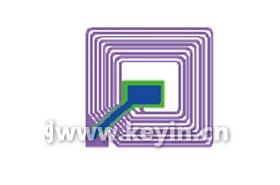At present, the performance and price of passive RFID tag chips and insulating substrates commonly on the market are basically the same, so the advantages and disadvantages of passive RFID tags are concentrated in the manufacturing process and cost of the antenna. Figure 1 shows the manufacturing process of a passive RFID tag. From the technical point of view, the passive RFID tag antenna manufacturing process has the following three kinds: copper wire winding process, metal foil etching process and printing process. The copper wire winding process is slow in production, high in cost, and poor in environmental coordination of the antenna. It is currently used to make antennas for low frequency RFID tags with frequencies below 135 kHz. Metal foil etching process is the standard method for printing metal circuit boards, but it has the following defects in making passive RFID tag antennas: 1 high cost; 2 low precision; 3 large label size; 4 low efficiency; 5 pollution environment; The label substrate is single, and the label application field is limited; 7 the metal barrier, waterproof, anti-folding and other environmental friendliness are poor. The manufacture of passive RFID tag antennas by printing process has been widely concerned in recent years. Among them, the passive RFID tag antennas produced by the screen printing process are the most mature. Screen printing technology to print passive RFID tag antenna features Specifically, the screen printing process of printing passive RFID tag antennas is through the screen printing of conductive ink, printing on the paper, PET, PE and other printing materials. In this process, the screen used is usually a PET screen or a nickel foil screen or the like. The thickness of the ink layer of the antenna coil is achieved by changing the mesh number of the screen. For high-frequency RFID tags, the antenna coil consists of two layers of conductor loops. When printing, it is necessary to overprint three times to complete the printing of one antenna. The second overprinting is printed with an insulating ink layer to prevent shorting of the upper and lower printed conductors. The printed passive RFID tag antenna and the chip are generally connected using the Flip-Chip process, that is, the two solder joints of the chip are directly placed down to the two connection ends of the coil, and then fixed by conductive adhesive, conductive adhesive After drying, the chip forms a permanent mechanical and electrical connection to the antenna connection. The screen printing process to print passive RFID tag antennas has the following advantages: 1 printing speed is fast and the degree of automation is high; 2 The uniformity of the wire is good, and the small gap coil can be printed, which is convenient for miniaturization of the label; 3 uses less conductive material; 4 product quality is stable; 5 The printing process has no waste, no pollution, and meets the requirements of national green environmental protection. Effect of Screen Printing Process on Performance of Passive RFID Tag Antenna 1. Study on the stability of screen printed passive RFID tag antenna In the printing of passive RFID tag antennas, stability is a very important premise, and high stability can be used for mass production. Below, we analyze the consistency of the antennas produced under the same screen printing process conditions through experiments. Experimental conditions: ordinary screen printing workshop Experimental equipment: flat semi-automatic screen printing machine, ordinary universal meter Process parameters: The screen material is polyester, and the scraper hardness is 60. The squeegee angle is 65°, the squeegee moving speed is 4m/min, and the conductive ink viscosity is 90pa.s. Experimental procedure: 14 passive RFID tag antennas (shown in Figures 2 to 3) were printed, and the impedance values ​​of the antennas were measured to analyze the reliability of the screen printed passive RFID tag antenna. The results are shown in Table 1. Through the reader's reading experiments on antennas A and B, we found that the experimentally printed antennas have consistent reading distances. Therefore, the screen printing process conditions can meet the requirements of mass production of passive RFID tag antennas. Olive Wood Dish,Wood Dish With 2 Sections,Eco-Friendly Olive Wood Dish,Dish With 3 Sections SHAOXING GENTSWELL ARTS & CRAFTS CO.,LTD , https://www.sxolivewood.com Figure 1 Manufacture of passive RFID tags
Figure 1 Manufacture of passive RFID tags  Figure 2 A passive RFID tag antenna
Figure 2 A passive RFID tag antenna  Figure 3 B passive RFID tag antenna
Figure 3 B passive RFID tag antenna
Table 1 Passive RFID tag antenna impedance value (unit: Ω) 
Passive RFID tag antenna screen printing process analysis
BAIDU_CLB_fillSlot("858283");